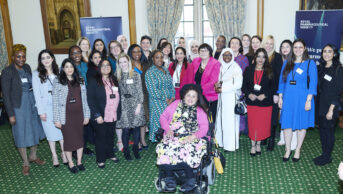
Shutterstock.com
It is well established that LGBTQIA+ people fare worse in our NHS, with poorer health outcomes and experiences[1]. In 2018, the UK Government Equalities Office published the LGBT action plan to address findings of discrimination, particularly related to gender identity of non-normative patients within the NHS[2]. One aspect of the plan aims to improve healthcare professionals’ awareness and understanding of LGBTQIA+ people through education and training, but how well this is embedded in medical and health curricula is not well known. More recently, the NHS staff survey indicated that LGBTQIA+ staff are more likely to face harassment and discrimination in the workplace[3].
In pharmacy, the General Pharmaceutical Council’s (GPhC’s) standards for pharmacy professionals refer to the need to “recognise and value diversity, and respect cultural differences — making sure that every person is treated fairly whatever their values and beliefs“[4]. The GPhC standards for initial education and training of pharmacists state “treat people as equals, with dignity and respect, and meet their own legal responsibilities under equality and human rights legislation, while respecting diversity and cultural differences”, and “assess and respond to the person’s particular health risks, taking account of individuals’ protected characteristics and background”[5]. Considered together, these standards are problematic in terms of inclusivity, since there is varying quality and quantity of training and education related to equality, diversity and inclusion issues in undergraduate and postgraduate programmes, as well as differing legal protections and social attitudes from the countries in which universities recruit students to study pharmacy. In these policies, equality and diversity are addressed, but inclusivity is not[6]. Specific learning for pharmacy professionals has only recently, in 2020, been designed to focus on transgender consultations[7]. In 2021, the Pharmacists’ Defence Association wrote to the GPhC and Pharmacy Schools Council, urging for the MPharm degree to be LGBT+ inclusive[8].
The results of our study are shocking but perhaps not surprising: we found an absence of LGBTQIA+ people in pharmacy materials and assessment, and curricula operate as hetero- and cisnormative
Concerns about marginalisation and lack of inclusion led us to undertake a UK-wide study, investigating to what extent undergraduate pharmacy education is inclusive of LGBTQIA+ people[9]. We also sought to establish whether there was alignment between how students experience the curriculum, and what educators teach and their intentions for the curriculum. When there is disconnect between this intended curriculum and experienced curriculum, it is possible to identify areas to reform in curriculum design. The results of our study are shocking but perhaps not surprising: we found an absence of LGBTQIA+ people in pharmacy materials and assessment, and curricula operate as hetero- and cisnormative. LGBTQIA+ people and issues were not represented in case studies, and there was little or no learning targeted at addressing the health inequalities experienced by marginalised people. For example, only 26.3% (n=5) of 19 programmes included same-sex history taking teaching in consultations skills training, 42.1% (n=8) of 19 programmes included gender history taking but only 15.8% (n=3) of 19 programmes taught the difference between behaviour and identity (i.e. a man may have sex with men but identify as heterosexual). A third of students reported that the presence of LGBTQI+ issues is usually in terms of HIV and AIDS (30.7%, n=55 of 179 students).
Many students were angry about this and felt unprepared to be inclusive practitioners. Overall, 179 students rated the coverage of LGBTQI+ content as either poor (23.5%, n=42) or very poor (52.5%, n=94). Only 22.2% (n=4) of 18 educators and 9.6% (n=13) of 136 student respondents agreed that their MPharm programme prepares them for caring for LGBTQIA+ people. Pharmacy learners were highly critical about the operation of undergraduate pharmacy education, and their criticisms should not be ignored. One student commented:
“Any coverage of LGBTQI+ issues would be a start, one that doesn’t just mention gay men and HIV in the same sentence and nowhere else, but particularly in relation to assuming a person’s gender or sexual orientation. Currently, the entire curriculum has been cis/heteronormative, assuming all patients are male or female and therefore have a penis or a vagina, respectively. Everything is taught from a very binary gendered viewpoint … it is clear the course was designed by a white, cishet, middle class man despite a very diverse student base.”
Where LGBTQIA+ teaching exists, this is usually done in a way that reinforces marginalisation
There are other findings from our study that indicate that educators knowingly do very little teaching around LGBTQIA+ issues, including basic sex and gender history taking. Where LGBTQIA+ teaching exists, this is usually done in a way that reinforces marginalisation; for example, gay men are discussed in teaching around HIV and trans females around hormone replacement therapy. While educators have been slow to act, learners want more incorporation of gender and sexuality education and the normalising of LGBTQIA+ people within the MPharm so that they do not feel unprepared for practice. Of note, while gay men and trans women were mentioned in students’ and staff responses in the study, there was an absence of voice about the broader LGBTQIA+ spectrum of identities and orientations.
It is clear from the study that pharmacy educators acknowledge that curricula are not ‘LBGTQIA+ allies’. Respondents’ suggestions that the GPhC has a role in changing curricula standards demonstrate a reluctance to address this unless mandated by the regulator. Until this happens, educators will continue to use barriers, such as time in the curriculum, confidence in subject matter and student acceptability, as defences to legitimise the reasons why LGBTQIA+ people are absent from their teaching.
Change is needed throughout higher education. A report by the National Union of Students in 2014 and a review by Stonewall in 2018 found that homophobia is still experienced in UK universities and that transphobia was prevalent[10,11]. In 2017, the University of Birmingham and Stonewall published a best practice guide for LGBTQ inclusivity in higher education[12]. The guide acknowledges that many higher education institutions publicise their equality, diversity and inclusion policies, yet the enacted and experienced curriculum is one that remains situated in heteronormativity and the hidden curriculum can marginalise LGBTQI+ people. The results from our study would indicate that this type of policy in higher education fails to influence the design and delivery of pharmacy degrees.
A method to disrupt hetero- and cisnormativity in curricula would be to reposition “social pharmacy” education to enable learners to challenge political, structural and institutional hegemony, and think critically about privilege and the heteronormative, cisnormative worldview. Explicit education around health inequalities in minority groups, and the discourse at play that “others” LGBTQIA+ people would offer learners critical tools to understand health inequality and overcome it. A tool for educators to expose othering and audit curricula would be adopting and applying the Ward-Gale model for LGBT inclusivity[12].
The pharmacy profession must step up to protect patients
Taking a critical stance to dissect a curriculum helps to expose that which is hidden and this diagnostic approach to programme appraisal can be insightful to educators but also spur change. This is important as, in 2021, the Council of Europe published a report on rising anti-LGBTI and transgender hate across Europe, including the UK, Poland, Hungary, Russia and Turkey (where most member states are named within the report for certain civil rights abuses)[13]. The report concludes that there are rising levels of hate speech and rhetoric, violence and hate crime, often alongside anti-LGBTQIA+ and anti-gender civil rights legislation from the media, governments and religious leaders, characterised as structural and societal homophobia and transphobia with regressing equality. It also outlines a prevailing heteronormative heterosexualism across Europe in the name of tradition, religious and family values and the “natural order”. The UK is criticised for anti-trans sentiment, with a sharp rise in transphobic and homophobic crime[13].
With this knowledge, the pharmacy profession must step up to protect patients. A way to do this would be clear, unambiguous standards on LGBTQIA+ care within the GPhC’s standards for the initial education, training of pharmacy professionals and further clarity in practice standards. Listening to the student voice expressed in our study should act as a call to action for the profession and educators of future pharmacists.
The findings of our study indicate that students feel unprepared to care for LGBTQIA+ people, and are naive to the health inequalities impacting queer people and the structural and societal violence at play. In some instances, this naivety is because sex and gender is not taught in pharmacy and so heteronormative assumptions persist in the understanding of biological sex, gender expression and identity and sex behaviour. Worryingly, some students perceive LGBTQIA+ issues to be “specialist” or not important, probably born from a curricula that marginalises queer health to oppressive discourse, such as HIV and mental health, as opposed to socialising and normalising LGBTQIA+ people and health in pharmacy training.
The impact of hetero/cisnormative curricula is that queer people are interacting with a profession ill equipped to understand and represent those who are non-normative in society, treating them as “other”, and contributing to the evidenced poorer health outcomes and experiences queer people have in healthcare[9,14]. While evidence exists that LGBTQIA+ people face health inequality, there is little published data from pharmacy practice. Case studies in pharmacy practice demonstrate how a mindful approach to LGBTQIA+ health in pharmacy can lead to positive patient outcomes; these case examples can be supported and furthered if all pharmacy professionals engage with the LGBT Foundation’s ‘Pride in Practice’ programme, endorsed by the GPhC and the Royal Pharmaceutical Society[15–19].

Health inequalities
The Royal Pharmaceutical Society’s policy on health inequalities was drawn up in January 2023 following a presentation by Michael Marmot, director of the Institute for Health Equity, at the RPS annual conference in November 2022. The presentation highlighted the stark health inequalities across Britain.
While community pharmacies are most frequently located in areas of high deprivation, people living in these areas do not access the full range of services that are available. To mitigate this, the policy calls on pharmacies to not only think about the services it provides but also how it provides them by considering three actions:
- Deepening understanding of health inequalities
- This means developing an insight into the demographics of the population served by pharmacies using population health statistics and by engaging with patients directly through local community or faith groups.
- Understanding and improving pharmacy culture
- This calls on the whole pharmacy team to create a welcoming culture for all patients, empowering them to take an active role in their own care, and improving communication skills within the team and with patients.
- Improving structural barriers
- This calls for improving accessibility of patient information resources and incorporating health inequalities into pharmacy training and education to tackle wider barriers to care.
- 1LGBT health. NHS England. 2019.https://www.england.nhs.uk/about/equality/equality-hub/patient-equalities-programme/lgbt-health/ (accessed Mar 2023).
- 2LGBT Action Plan: Improving the Lives of Lesbian, Gay, Bisexual and Transgender People. Government Equalities Office. 2018.https://assets.publishing.service.gov.uk/government/uploads/system/uploads/attachment_data/file/721367/GEO-LGBT-Action-Plan.pdf (accessed Mar 2023).
- 3McCay L. What experience do LGBTQ+ people have in the NHS these days? NHS Confederation. 2022.https://www.nhsconfed.org/articles/what-experience-do-lgbtq-people-have-nhs-these-days (accessed Mar 2023).
- 4Standards for pharmacy professionals. General Pharmaceutical Council. 2017.https://www.pharmacyregulation.org/sites/default/files/standards_for_pharmacy_professionals_may_2017_0.pdf (accessed Mar 2023).
- 5Standards for the initial education and training of pharmacists. General Pharmaceutical Council. 2021.https://www.pharmacyregulation.org/sites/default/files/document/standards-for-the-initial-education-and-training-of-pharmacists-january-2021_final-v1.3.pdf (accessed Mar 2023).
- 6What we mean by ‘equality, diversity and inclusion’. Social Work England. 2021.https://www.socialworkengland.org.uk/about/equality-diversity-and-inclusion/what-we-mean-by-equality-diversity-and-inclusion/#:~:text=When we talk about equality%2C diversity and inclusion%2C,is treated fairly and with dignity and respect (accessed Mar 2023).
- 7Transgender healthcare – consulting with dignity and respect. Centre for Postgraduate Pharmacy Education. 2022.https://www.cppe.ac.uk/programmes/l?t=ConsultTran-E-01&evid=52719 (accessed Mar 2023).
- 8PDA LGBT+ Network writes to GPhC and PhSC on more inclusion of LGBT+ education in the MPharm programme. Pharmacists’ Defence Association. 2021.https://www.the-pda.org/pda-lgbt-network-writes-to-gphc-and-phsc-on-more-inclusion-of-lgbt-education-in-the-mpharm-programme/ (accessed Mar 2023).
- 9Mawdsley A, Willis SC. Hetero‐ and cisnormativity—UK pharmacy education as a queer opponent. Medical Education. 2023. doi:10.1111/medu.15018
- 11LGBT in Britain – Health. Stonewall. 2018.https://www.stonewall.org.uk/lgbt-britain-health (accessed Mar 2023).
- 12LGBTQ Inclusivity in the Higher Education Curriculum: A Best Practice Guide. University of Birmingham. 2017.https://intranet.birmingham.ac.uk/staff/teaching-academy/documents/public/lgbt-best-practice-guide.PDF?_ga=2.262943246.343322391.1617015692-582173947.1617015692 (accessed Mar 2023).
- 13Combating rising hate against LGBTI people in Europe. Committee on Equality and Non-Discrimination. 2021.https://assembly.coe.int/LifeRay/EGA/Pdf/TextesProvisoires/2021/20210921-RisingHateLGBTI-EN.pdf (accessed Mar 2023).
- 14Garner C. The homophobia I faced as a pharmacy student is also evident in our health service. The Pharmaceutical Journal. 2020.https://pharmaceutical-journal.com/article/opinion/the-homophobia-i-faced-as-a-pharmacy-student-is-also-evident-in-our-health-service (accessed Mar 2023).
- 15Dipesh Raghwani: ‘We are proactive in support of LGBT patients’. Pharmaceutical Journal. 2019. doi:10.1211/pj.2019.20206481
- 16Marshall C. ‘Here’s how pharmacy can support LGBT patients’ health’. C+D. 2019.https://www.chemistanddruggist.co.uk/CD001369/Heres-how-pharmacy-can-support-LGBT-patients-health (accessed Mar 2023).
- 17It is time to act on the inequalities in treatment for substance misuse among LGBTQ+ people. Pharmaceutical Journal. 2022. doi:10.1211/pj.2022.1.130330
- 18LGBTQ Peoples Experiences of Medicines and Pharmacies. Brighton and Hove LGBT Switchboard. 2017.https://www.switchboard.org.uk/wp-content/uploads/2013/09/LGBTQ-Medicines-and-Pharmacies-Report-Final.pdf (accessed Mar 2023).
- 19Pride in Pharmacy. LGBT Foundation. 2022.https://docs.google.com/presentation/d/1Q4UkdTaCe0yTwcozbYwP0YwfAGTNJYCfQj28zdXRZnw/edit#slide=id.g1171989f293_0_11 (accessed Mar 2023).


